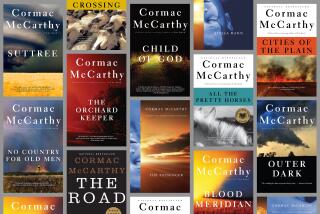Which Wardrobe Is Lion’s?
You are a child returning from adventures with a lion and a witch in the magical land of Narnia when you tumble out of a wardrobe and you’re staring at the secretary of the English department at Westmont College.
Alternatively, you might pop out of a wardrobe and into a research library at Wheaton College outside Chicago, gaping at a clutch of C.S. Lewis scholars who, of course, would be gaping back at you.
That’s how fantasy works. It’s as unpredictable as the fact that two small Christian colleges both lay claim to owning a big, portable closet that may have inspired Lewis when he penned “The Lion, the Witch and the Wardrobe,” the first tale in his “Chronicles of Narnia” series for children.
Which campus deserves bragging rights?
Nobody knows. But with a $150-million hit movie drawing Christmas crowds, some 95 million “Narnia” books in circulation since 1950 and a current “Christianity Today” cover story likening Clive Staples Lewis of Oxford to Elvis Aron Presley of Memphis, there has been plenty of interest.
Further fueling the curiosity, the Disney film has riled some critics who say it serves an evangelical agenda. Lewis, one of the 20th century’s most noted theologians, built his children’s stories around themes of sin and redemption, with Aslan, Narnia’s lion, standing in for Jesus.
Besieged with media inquiries, each school tells reporters much the same thing: Their wardrobes were certainly owned by the prolific don, who died Nov. 22, 1963. However, it is unclear whether Lewis had either one in mind when the four kids in his story poked into an armoire and somehow wound up cavorting with the chatty animals inhabiting the weird world of Narnia.
At Westmont’s leafy campus outside Santa Barbara, English professor Paul Delaney recently showed visitors the no-frills piece of furniture at issue in the lobby outside some faculty offices.
“We can’t say for sure that it’s the wardrobe,” he said, “but it definitely came from his house and closely matches the description in the book.”
Westmont’s website is less reserved, saying that the Lewis wardrobe in Reynolds Hall “served as a model for the magical one he described in his famous children’s book.”
At Wheaton, officials downplay the possibility that their Marion E. Wade Center research library holds the portal to Narnia. Even so, they’ve posted a sign near their wardrobe that leaves little doubt as to their true position: “We do not take responsibility for people disappearing.”
Built to resemble an English cottage, the center also has Lewis’ writing desk and more than 2,000 of his letters, as well as a mountain of documents chronicling the careers of Lewis, J.R.R. Tolkien and five other British writers.
“For casual visitors, the wardrobe is the biggest draw,” said archivist Heidi Truty. “When families -- even students -- come through the door, the question we hear most often is: ‘Where’s the wardrobe?’ ”
Snagged at a 1973 auction in England by a Wheaton economics professor, the school’s ornate, double-doored black oak wardrobe was handcrafted by Lewis’ grandfather, a shipbuilder in Belfast. Although it barely resembles the modest piece described in “Narnia,” it still may have triggered the imagination of Lewis, known by friends as Jack.
“A cousin of Lewis’ visited and mentioned that, as children, they used to climb into this wardrobe and Jack would tell adventure stories to his playmates,” Truty said.
The year after Wheaton’s find, Westmont students doing a semester in England learned that the owners of the author’s old house had found a wardrobe that was to be turned into scrap because it could not be carted out whole through a remodeled, narrower doorway. The students took it off their hands for about $50, had it dismantled, and shipped it back to campus.
Unlike Wheaton’s version, this wardrobe is as “perfectly ordinary” as the Narnia entryway into a world of fantasy, Westmont’s Delaney points out.
Like the one in the book, it has a single door with a mirror and a threshold low enough for a small child to step into -- as opposed to the 3-foot-high jump required to access the Wheaton wardrobe.
“Read the book,” Delaney said, with the weary authority of a veteran English professor.
At both campuses, tattered furs hang inside the wardrobes, just as they did in the book. Neither one is used to store backpacks, laptops or other paraphernalia of modern college life.
Of course, wardrobes in old English houses were as common as teakettles, and Lewis may have found his inspiration outside his home.
David Colbert, author of a guide called “The Magical Worlds of Narnia,” contends that Lewis’ wardrobe “was one of his many borrowings from E. Nesbit, one of Britain’s favorite authors.”
“The description of the wardrobe and the room and the world just beyond are almost direct borrowings from Nesbit’s ‘The Aunt and Amabel,’ ” Colbert said, “though, of course, Lewis’ story quickly heads in another direction.”
*
(BEGIN TEXT OF INFOBOX)
The writer and the wardrobe
Excerpts from “The Chronicles of Narnia: The Lion, The Witch and the Wardrobe” by C.S. Lewis. In the book, a wardrobe serves as a portal to the magical land of Narnia.
And shortly after that, they looked into a room that was quite empty except for one big wardrobe; the sort that has a looking-glass in the door....
*
And presently instead of rough branches brushing past her she felt coats, and instead of crunching snow under her feet she felt wooden boards, and all at once she found herself jumping out of the wardrobe into the same empty room from which the whole adventure had started.
*
“Why, you goose,” said Susan, putting her head inside and pulling the fur coats apart, “it’s just an ordinary wardrobe; look! there’s the back of it.”
*
“Eh? What’s that? Yes, of course you’ll get back to Narnia again someday.... But don’t go trying to use the same route twice.” And that is the very end of the adventure of the wardrobe.
More to Read
Sign up for our Book Club newsletter
Get the latest news, events and more from the Los Angeles Times Book Club, and help us get L.A. reading and talking.
You may occasionally receive promotional content from the Los Angeles Times.







